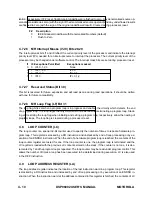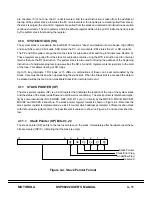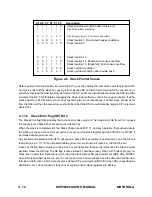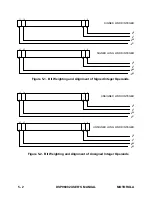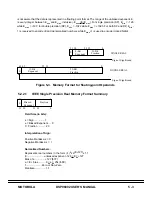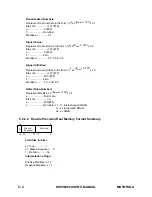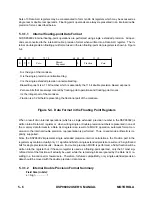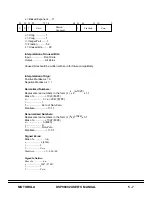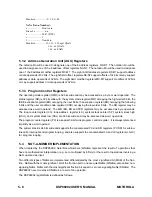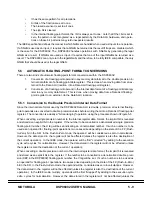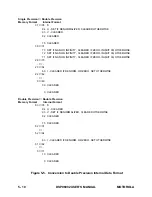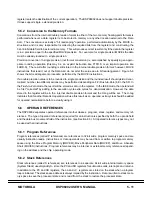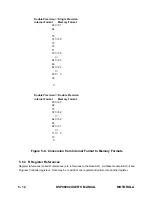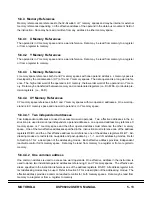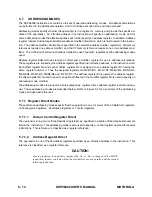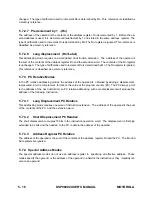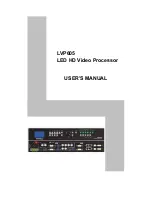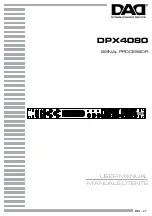
MOTOROLA
DSP96002 USER’S MANUAL
5 - 1
SECTION 5
DATA ORGANIZATION AND ADDRESSING MODES
5.1
OPERAND SIZES
Operand sizes are defined as follows: a byte is 8 bits long, a short word is 16 bits long, a word is 32 bits
long and a long word is 64 bits long. For floating-point operations the operand sizes are defined as follows:
a single real is 32 bits long, a double real is 64 bits long and a register operand is 96 bits long. The operand
size for each instruction is either explicitly encoded in the instruction or implicitly defined by the instruction
operation.
5.2
DATA ORGANIZATION IN MEMORY
Program memory is 32 bits wide and supports 32-bit instruction words and instruction extension words.
The X and Y data memories are each 32 bits wide and support word and single real operands. The X and
Y memories may be referenced as a single 64-bit wide memory space (the "L" space) to support long word
and double real operands.
5.2.1 Integer Memory Data Formats
The DSP96002 supports four integer memory data formats:
•
Signed Word Integer - 32 bits wide with two’s complement representation.
•
Signed Long Word Integer - 64 bits wide with two’s complement representation.
•
Unsigned Word Integer - 32 bits wide with unsigned magnitude representation.
•
Unsigned Long Word Integer - 64 bits wide with unsigned magnitude representation.
The bit weighting for signed integers is presented in Figure 5-1. The bit weighting for unsigned integers is
presented in Figure 5-2.
The DSP96002 does not support direct operations on Long Word Integers but they can be produced as
result of some ALU operations or as a result of a Long Move.
5.2.2 Floating-point Memory Data Formats
The DSP96002 supports two floating-point memory data formats: Single Precision (32 bits) and Double
Precision (64 bits), both fully complying with the IEEE Standard 754 for Binary Floating-Point Arithmetic.
The memory formats for floating-point operands supported by DSP96002 are shown in Figure 5-3. The
memory format for single and double real operands which conform to the IEEE 754 standard are shown
below. Note that the stored exponent (e) is unsigned (i. e., biased positive) and positioned in the significant
bits above those for the mantissa. By doing this, data can be ordered (sorted) by an integer machine which
Summary of Contents for DSP96002
Page 3: ...1 2 DSP96002 USER S MANUAL MOTOROLA ...
Page 38: ...MOTOROLA DSP96002 USER S MANUAL 3 15 Figure 3 4 Modulo Arithmetic Unit Block Diagram ...
Page 39: ...3 16 DSP96002 USER S MANUAL MOTOROLA ...
Page 53: ...4 14 DSP96002 USER S MANUAL MOTOROLA ...
Page 76: ...MOTOROLA DSP96002 USER S MANUAL 5 23 Figure 5 8 Address Modifier Summary ...
Page 86: ...6 10 DSP96002 USER S MANUAL MOTOROLA ...
Page 101: ...MOTOROLA DSP96002 USER S MANUAL 7 15 Figure 7 9 HI Block Diagram One Port ...
Page 140: ...7 54 DSP96002 USER S MANUAL MOTOROLA ...
Page 166: ...9 10 DSP96002 USER S MANUAL MOTOROLA ...
Page 181: ...MOTOROLA DSP96002 USER S MANUAL 10 15 Figure 10 8 Program Address Bus FIFO ...
Page 337: ...MOTOROLA DSP96002 USER S MANUAL A 149 ...
Page 404: ...A 216 DSP96002 USER S MANUAL MOTOROLA PC xxxx D ...
Page 460: ...A 272 DSP96002 USER S MANUAL MOTOROLA SIOP Not affected ...
Page 484: ...A 296 DSP96002 USER S MANUAL MOTOROLA SSH PC SSL SR SP 1 SP ...
Page 519: ...MOTOROLA DSP96002 USER S MANUAL A 331 ...
Page 718: ...MOTOROLA DSP96002 USER S MANUAL B 199 ...
Page 871: ... MOTOROLA INC 1994 MOTOROLA TECHNICAL DATA SEMICONDUCTOR M Addendum ...
Page 888: ...MOTOROLA INDEX 1 INDEX ...
Page 889: ......










